You can protect marine ecosystems while creating stunning coral-inspired accessories by choosing sustainable alternatives like recycled ocean plastic, which diverts waste from marine habitats while offering coral-like aesthetics. Plant-based bioplastics derived from cornstarch mimic coral’s vibrant colors and textures, while lab-grown coral substitutes replicate natural growth processes without reef impact. Reclaimed glass, algae-derived polymers, and recycled metal frameworks also provide beautiful coral aesthetics with considerably lower environmental impact. Exploring these certified sustainable options reveals countless creative possibilities for ocean-friendly designs.
Understanding the Environmental Impact of Natural Coral Harvesting
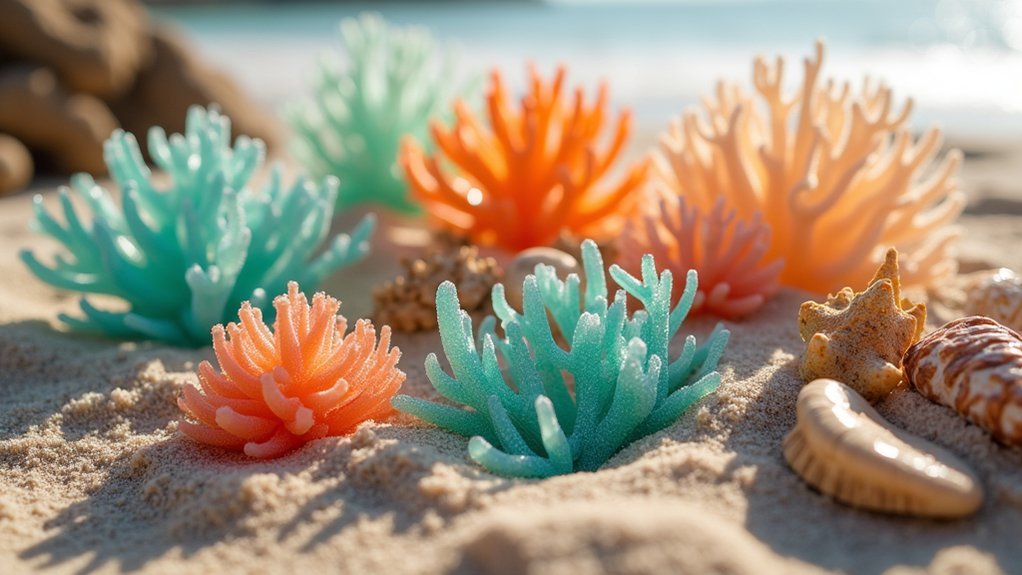
When you purchase coral jewelry or decorative items, you’re likely unaware that your choice contributes to one of the ocean’s most pressing environmental crises.
Your innocent coral purchase unknowingly fuels one of the ocean’s most devastating environmental disasters.
Natural coral harvesting devastates coral reefs, which shelter over 25% of marine species and serve as essential breeding grounds. Your demand for coral accessories fuels unsustainable harvesting practices that disrupt marine biodiversity when these ecosystems already face mounting pressure from climate change and pollution.
You’re participating in an industry that’s already destroyed 50% of the world’s coral reefs.
When harvesters remove coral, they’re eliminating natural storm barriers that protect coastal communities from erosion and severe weather.
Sustainable business practices require recognizing that coral reefs can’t regenerate fast enough to meet current market demands, making every coral purchase a vote against ocean conservation.
Recycled Ocean Plastic as a Coral Alternative
While traditional coral harvesting destroys marine ecosystems, recycled ocean plastic offers you a revolutionary alternative that tackles two environmental crises simultaneously.
You’ll find that recycled ocean plastic accessories deliver stunning coral-like aesthetics while protecting marine life from harmful extraction practices. This innovative approach transforms ocean waste into beautiful products that support coral conservation efforts.
Here’s how recycled ocean plastic benefits you and the environment:
- Diverts plastic waste from coral reefs and marine habitats
- Replicates coral’s natural beauty without harming living organisms
- Promotes circular economy principles by repurposing waste materials
- Raises awareness about ocean pollution’s impact on marine ecosystems
When you choose recycled ocean plastic accessories, you’re directly contributing to ocean cleanup initiatives while supporting sustainable fashion that protects marine life and promotes coral conservation.
Plant-Based Bioplastics for Coral-Inspired Jewelry
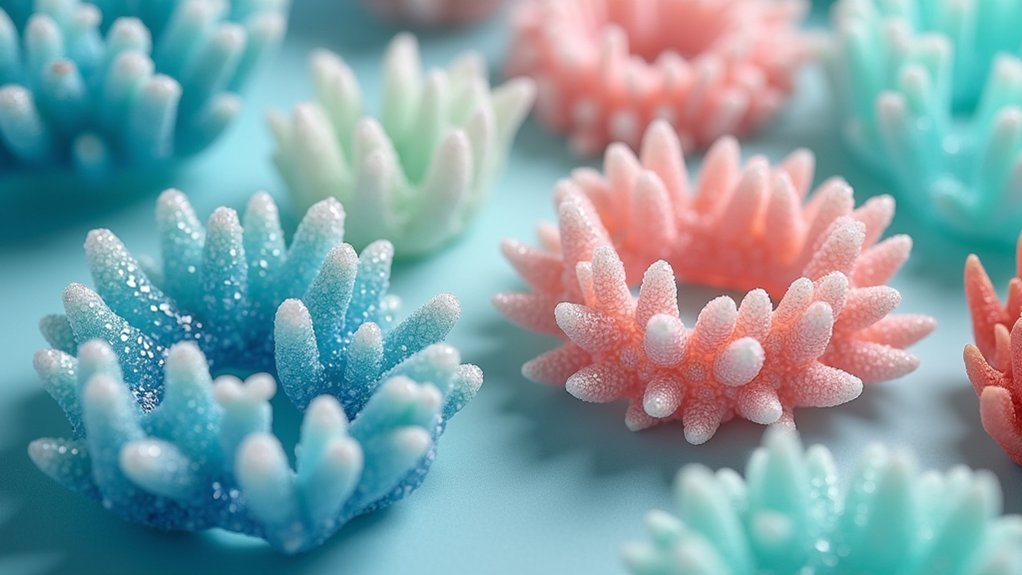
Plant-based bioplastics revolutionize coral-inspired jewelry by offering you biodegradable accessories that capture coral’s intricate beauty without harming marine ecosystems.
These innovative materials, derived from cornstarch and soybean oil, let you wear stunning pieces that mimic various coral species’ vibrant colors and textures. You’ll appreciate how these bioplastics degrade naturally over time, replacing petroleum-based alternatives with sustainable options.
When you choose coral-inspired bioplastic jewelry, you’re supporting lower carbon emissions during production while promoting marine conservation awareness.
The manufacturing process creates intricate designs that reflect natural reef beauty without depleting precious underwater habitats. You can confidently accessorize knowing you’re contributing to global climate efforts and protecting endangered coral species.
These eco-friendly alternatives prove you don’t need to sacrifice style for sustainability in fashion choices.
Lab-Grown Coral Substitutes Using Biotechnology
Biotechnology breakthroughs now enable scientists to cultivate coral substitutes in laboratory settings, replicating nature’s complex growth processes without touching a single reef.
You’ll find these lab-grown coral alternatives offer identical aesthetics while supporting conservation efforts. Through bioengineering, researchers create materials that mirror natural coral’s chemical composition and structural properties. This biotechnology revolutionizes sustainable production by eliminating wild harvesting.
Here’s what makes lab-grown coral substitutes superior:
- Controlled cultivation – Genetic engineering and tissue culture techniques guarantee consistent quality and supply
- Environmental protection – Zero impact on marine ecosystems and existing reef systems
- Industry alignment – Fashion and accessory brands can meet sustainability goals while maintaining product appeal
- Conservation support – Reduced demand for wild coral directly contributes to reef preservation efforts
You’re supporting marine conservation while accessing beautiful coral-inspired accessories.
Reclaimed Glass Materials for Ocean-Themed Accessories
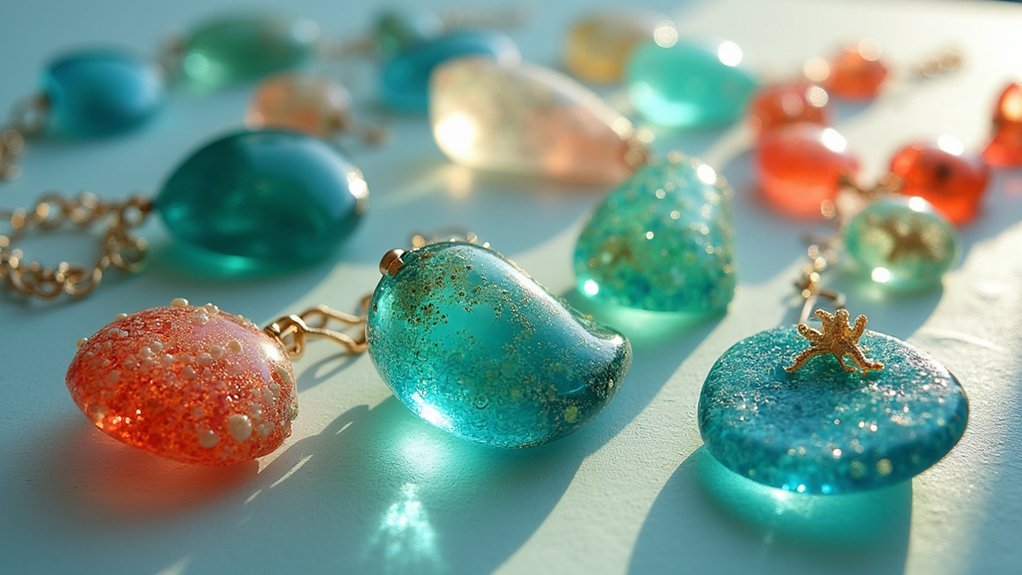
Since ocean conservation concerns continue growing, reclaimed glass materials offer you an innovative way to embrace marine-inspired accessories without harming aquatic ecosystems.
You’ll find these sustainable alternatives transform discarded bottles and containers into stunning jewelry that mimics coral colonies’ vibrant colors and textures. When you choose reclaimed glass accessories, you’re reducing landfill waste while supporting artisans who champion ocean conservation awareness.
Marine biologist research shows that traditional coral harvesting damages fragile reef systems, making reclaimed glass an ethical substitute.
You’ll discover these upcycled materials capture the ocean’s beauty through unique patterns and hues that resemble natural coral formations. By wearing reclaimed glass accessories, you’re promoting sustainable practices while showcasing your commitment to protecting marine environments.
Sustainable Wood Options for Coral-Like Textures
While glass materials capture the ocean’s translucent beauty, sustainable wood options provide you with coral-inspired textures that feel organic and earthy.
These eco-friendly substitutes deliver authentic coral-like textures without harming marine ecosystems.
You’ll find exceptional alternatives in these materials:
- Bamboo – Growing up to 35 inches daily, it’s incredibly renewable and offers natural ridged patterns.
- Cork – Harvested without tree damage, regenerating every nine years with distinctive porous textures.
- Reclaimed wood – Sourced from old furniture and buildings, providing rustic coral-like appearances.
- Fast-growth hardwoods – Rapidly renewable species that mimic coral’s branching structures.
Eco-Friendly Resin Alternatives Made From Natural Sources
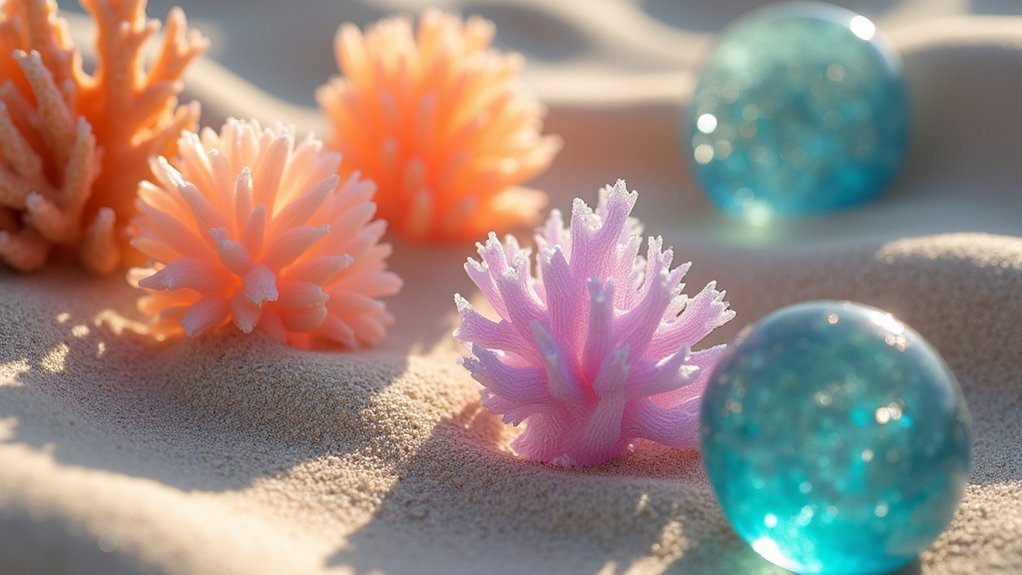
You’ll find that plant-based resins offer an excellent coral substitute while reducing your environmental impact through bio-based epoxies derived from plant oils and biodegradable options like PLA from corn starch.
These natural alternatives don’t compromise on the aesthetic qualities you’re seeking, as they maintain similar visual appeal to traditional synthetic resins.
When you choose marine-safe bio materials, you’re protecting ocean ecosystems while creating beautiful accessories that won’t harm marine life if they enter waterways.
Plant-Based Resin Options
Although traditional petroleum-based resins have dominated the jewelry industry for decades, plant-based alternatives now offer compelling eco-friendly options that don’t compromise on quality or aesthetics.
You’ll find these innovative plant-based resins derived from soybeans, corn, and other renewable materials provide an excellent marine-safe building material for coral-inspired accessories.
These bio-resins deliver impressive benefits:
- Reduced carbon footprint through renewable resource utilization and biodegradable properties
- Customizable characteristics using innovations like zein (corn-derived protein) for varying hardness and durability
- Support for sustainable agriculture by encouraging responsible crop harvesting practices
- Chemical-free composition eliminating harmful toxins found in synthetic alternatives
You’re contributing to healthier ecosystems while creating stunning accessories that mimic coral’s natural beauty without environmental harm.
Marine-Safe Bio Materials
Marine-safe bio materials represent the next evolution in sustainable accessory manufacturing, pushing beyond basic plant-based options to create resins specifically engineered for ocean protection.
You’ll find these advanced materials derived from algae sources that actively absorb carbon dioxide during production, creating a negative environmental footprint. Unlike traditional resins that leach toxins into marine environments, these bio-based alternatives break down harmlessly without endangering sea life.
You can now access custom formulations that perfectly mimic coral’s natural appearance and texture, giving you authentic-looking jewelry without contributing to reef destruction.
These innovative materials match synthetic resin performance in strength and durability while supporting ocean conservation efforts. By choosing marine-safe bio materials, you’re directly combating plastic pollution and protecting fragile marine ecosystems for future generations.
Upcycled Materials From Marine Cleanup Initiatives
You can support coral reef protection by choosing accessories made from ocean plastic that’s been recovered through marine cleanup initiatives.
When you purchase jewelry crafted from this upcycled waste, you’re directly contributing to the removal of harmful debris that threatens marine ecosystems.
This transformation process doesn’t just create beautiful accessories—it considerably reduces environmental impact while funding ongoing ocean conservation efforts.
Ocean Plastic Recovery Methods
When ocean cleanup initiatives transform discarded marine plastics into stunning coral alternatives, they’re creating a powerful solution that tackles two environmental challenges simultaneously.
Ocean plastic recovery methods have evolved into sophisticated operations that combine environmental impact with practical innovation.
These recovery processes involve several key approaches:
- Beach cleanup drives where volunteers collect debris while building community engagement around marine conservation
- Advanced sorting systems that separate plastics by type and quality for ideal upcycling potential
- Specialized collection vessels that target offshore plastic accumulations in ocean gyres
- Processing facilities that clean and transform recovered materials into manufacturing-ready materials
Companies like 4ocean demonstrate how systematic collection can remove millions of pounds of marine debris.
Through strategic upcycling, this recovered plastic becomes high-quality coral substitutes that support sustainable fashion while protecting marine ecosystems.
Transforming Waste Into Jewelry
Every bracelet, necklace, and earring crafted from recovered ocean plastic carries a tangible piece of marine conservation history. You’re wearing transformed debris that once threatened marine life, now repurposed into stunning accessories that spark conversations about ocean health.
| Material Type | Ocean Impact | Design Potential | Conservation Value | Production Method |
|---|---|---|---|---|
| Plastic bottles | Microplastic prevention | Vibrant colors | 5 lbs trash removed | Heat molding |
| Ocean glass | Sharp debris elimination | Sea-worn textures | Habitat protection | Tumbling process |
| Fishing nets | Marine entanglement reduction | Rope-like patterns | Wildlife rescue | Fiber weaving |
| Aluminum cans | Metal pollution decrease | Metallic finishes | Ecosystem restoration | Melting reformation |
| Bottle caps | Small debris collection | Colorful accents | Beach cleanup support | Compression shaping |
Companies creating these different materials often fund ongoing cleanup initiatives. When you purchase upcycled ocean jewelry, you’re directly supporting efforts to protect the world’s oceans while making a fashion statement that matters.
Environmental Impact Reduction
While traditional jewelry manufacturing creates approximately 20 tons of waste for every gold ring produced, upcycled marine accessories flip this equation entirely.
You’re choosing products that transform ocean debris into beautiful accessories while greatly reducing environmental impact.
When you agree to receive science news about marine conservation, you’ll discover how these innovations work:
- Waste Transformation: Recycled plastics and glass from ocean cleanups become stunning jewelry pieces
- Carbon Footprint Reduction: Eliminating new resource extraction considerably lowers manufacturing emissions
- Ocean Cleanup Multiplication: Each purchase removes substantial amounts of marine debris
- Awareness Amplification: Wearing these accessories sparks conversations about ocean conservation
All rights reserved to manufacturers pioneering these sustainable practices, you’re supporting meaningful environmental change through conscious consumer choices.
Bamboo Fiber Composites for Lightweight Accessories
As environmental consciousness drives innovation in fashion and accessory design, bamboo fiber composites emerge as a revolutionary material that’s transforming how you can create lightweight, durable accessories. You’ll find these composites offer exceptional strength while remaining completely biodegradable, making them perfect coral substitutes for jewelry and bags.
When you choose bamboo fiber composites, you’re selecting a material that grows rapidly—reaching maturity in just three to five years. You can enhance durability by combining these fibers with bioplastics while maintaining sustainability.
| Bamboo Composite Benefits | Traditional Materials |
|---|---|
| Absorbs CO₂ during growth | Releases emissions |
| 3-5 years to maturity | Decades to mature |
| Low energy production | High energy requirements |
| Biodegradable end-of-life | Persistent waste |
| Lightweight yet strong | Often heavier alternatives |
You’ll greatly reduce your carbon footprint since bamboo absorbs substantial carbon dioxide during growth phases.
Mushroom-Based Mycelium Materials in Jewelry Design
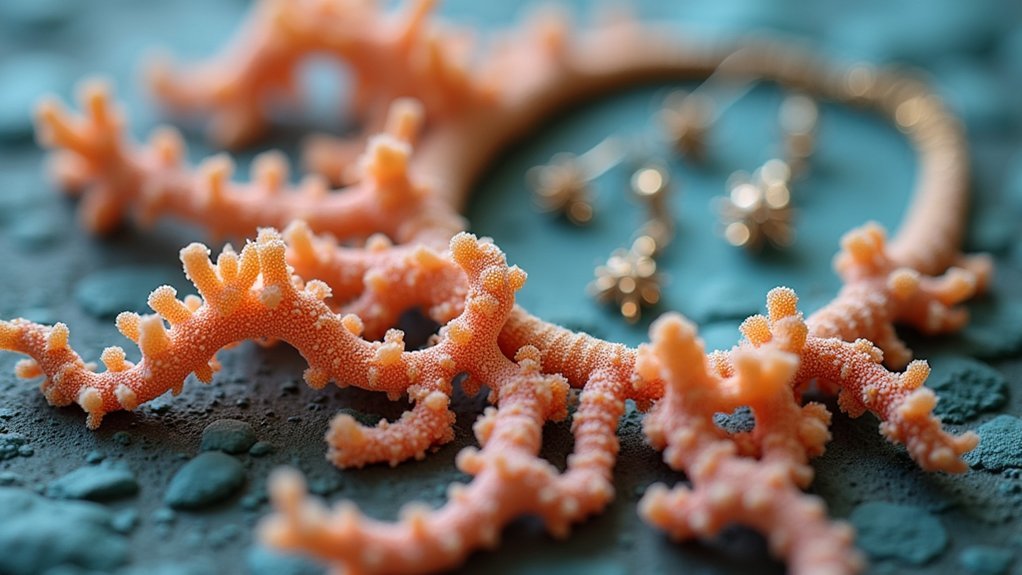
Though once considered an unconventional material, mushroom-based mycelium is revolutionizing jewelry design by offering designers like you a sustainable alternative that’s both environmentally responsible and aesthetically striking.
You’ll find mycelium’s cultivation process incredibly efficient, requiring minimal resources while utilizing agricultural waste. This root structure of fungi grows quickly and biodegrades naturally, making it an ideal coral substitute.
You can treat and dye mycelium in various colors without compromising its eco-friendly properties, giving you creative freedom while maintaining non-toxic standards.
Here’s what makes mycelium exceptional for jewelry:
- Durability – Comparable strength to leather and conventional materials
- Sustainability – Promotes circular economic models in fashion
- Versatility – Adapts to innovative design concepts
- Environmental impact – Considerably reduces ecological footprint
Algae-Derived Polymers for Sustainable Coral Replicas
You’ll find algae-derived polymers offer remarkable advantages as coral substitutes, providing biodegradable alternatives that actually sequester carbon during growth while eliminating petroleum-based plastics from your accessories.
The production process transforms various algae species into durable materials that closely mimic coral’s natural texture and appearance through careful engineering.
You’re supporting both marine conservation and waste reduction when you choose these innovative polymers for your jewelry and decor items.
Algae Polymer Benefits
While traditional plastic coral replicas contribute to environmental degradation, algae-derived polymers offer a revolutionary biodegradable alternative that transforms how you can create sustainable accessories.
These innovative materials deliver exceptional benefits that’ll revolutionize your accessory designs:
- Environmental Impact: You’ll dramatically reduce your carbon footprint since algae polymers use renewable resources instead of fossil fuels, while promoting ocean health through carbon sequestration.
- Performance Quality: You’ll achieve excellent mechanical properties that guarantee durability while perfectly mimicking real coral’s texture and appearance.
- Sustainability: You’ll support the circular economy with completely compostable products that eliminate reliance on traditional plastics.
- Marine Protection: You’ll create stunning coral replicas without harming delicate marine ecosystems, preserving biodiversity for future generations.
Production Process Overview
Manufacturing algae-derived polymers begins with cultivating specific algae species in carefully controlled bioreactors that optimize growth conditions through precise temperature, pH, and nutrient management.
You’ll find this process naturally captures carbon dioxide while algae photosynthesize, creating an environmentally beneficial production cycle.
Once harvested, you extract polysaccharides through specialized processing techniques that preserve the material’s structural integrity.
These extracted compounds are then transformed into biodegradable polymers through chemical treatment and purification.
You can shape these polymers into coral-like structures using molding techniques, adding natural colorants to achieve authentic coral appearances.
The resulting materials maintain durability comparable to traditional coral while eliminating environmental damage from ocean harvesting, giving you sustainable accessories that support marine conservation.
Ceramic and Clay Alternatives for Coral Aesthetics
As environmental concerns reshape consumer choices, ceramic and clay alternatives offer stunning coral-like aesthetics without contributing to marine ecosystem destruction.
You can achieve intricate coral textures and vibrant colors through specialized glazing techniques that replicate nature’s artistry. These materials provide consistent availability while real coral faces environmental threats and decades-long growth cycles.
Here’s what makes ceramic and clay ideal coral substitutes:
- Local sourcing – You’ll reduce carbon footprint by using regional, non-toxic clays and glazes.
- Mass production capability – You can meet demand efficiently without waiting for natural growth cycles.
- Circular economy benefits – You’re supporting recyclable and repurposable materials that minimize waste.
- Conservation impact – You’ll help protect marine reefs by reducing demand for harvested coral.
Your choice supports both artistic expression and ocean preservation.
Recycled Metal Frameworks for Coral-Structure Jewelry
Beyond ceramic applications, recycled metal frameworks open exciting possibilities for coral-inspired jewelry that captures nature’s intricate branching patterns. You’ll find that using recycled metals reduces mining demands while protecting both marine and terrestrial ecosystems from destructive extraction processes.
| Technique | Result | Environmental Impact |
|---|---|---|
| Casting | Complex coral textures | 60% less energy consumption |
| Weaving | Delicate branch patterns | Reduced carbon emissions |
| Forming | Natural reef structures | Zero new mining required |
| Texturing | Organic surface details | Habitat protection |
| Assembly | Multi-layered designs | Waste material repurposing |
When you choose recycled metal jewelry, you’re supporting artisans who’ve mastered these sustainable techniques. These pieces maintain coral’s natural beauty while raising awareness about marine conservation. You’ll own accessories that protect the very ecosystems they celebrate.
Certification Programs for Sustainable Coral Substitutes
When you’re choosing sustainable coral substitutes, you’ll need to look for third-party verification standards that authenticate a product’s environmental claims.
These certification programs require thorough environmental impact assessments that evaluate everything from sourcing practices to production methods.
You can trust these rigorous evaluations because they’re conducted by independent organizations that have no financial stake in the products they’re certifying.
Third-Party Verification Standards
While the market for coral substitutes continues expanding, third-party verification standards have emerged as essential tools for ensuring these alternatives meet rigorous environmental and ethical criteria.
You’ll find that these verification systems provide independent assessments that go beyond basic certification requirements, offering thorough evaluation of sourcing practices and environmental impact.
Third-party verification enhances your confidence in coral substitute products through:
- Independent auditing processes that validate sustainable sourcing claims without manufacturer bias
- Thorough supply chain tracking from raw material extraction to final product delivery
- Regular compliance monitoring ensuring ongoing adherence to environmental and ethical standards
- Transparent reporting systems providing you with detailed information about product sustainability credentials
These verification standards ultimately support conservation efforts while helping you make informed purchasing decisions.
Environmental Impact Assessments
Although third-party verification provides the framework for evaluating coral substitutes, environmental impact assessments (EIAs) form the scientific backbone that determines whether these alternatives truly support conservation goals. You’ll find that EIAs evaluate sustainability by examining the complete life cycle of substitute materials, ensuring they don’t contribute to ecosystem degradation.
| Assessment Phase | Key Criteria | Environmental Benefit |
|---|---|---|
| Material Sourcing | Biodegradable components | Reduced ocean pollution |
| Production Process | Energy efficiency standards | Lower carbon footprint |
| End-of-Life | Recyclability potential | Minimized waste impact |
When you choose certified substitutes, you’re supporting rigorous environmental standards that focus on materials like sustainable resins and recycled plastics. These assessments help regulatory bodies and conservation organizations collaborate effectively, creating certification programs that enhance your confidence in making environmentally responsible accessory choices.
Frequently Asked Questions
What Is Coral Similar To?
You’ll find coral resembles branching tree structures with intricate, porous textures. It’s similar to sponges in appearance, sharing organic, irregular patterns. Coral’s calcium carbonate composition creates hard, sculptural forms that mirror natural rock formations and crystalline structures.
Are Coral Beads Eco Friendly?
You shouldn’t consider coral beads eco-friendly because they’re harvested from endangered coral reefs, destroying crucial marine ecosystems. You’re contributing to habitat destruction and biodiversity loss when you choose real coral jewelry.
How Can We Make Coral Reef Sustainable?
You can make coral reefs sustainable by reducing pollution, supporting restoration projects, choosing reef-safe sunscreens, practicing responsible tourism, and avoiding coral products while promoting biodegradable alternatives in conservation efforts.
Is Coral Good for the Environment?
You’ll find coral’s incredibly beneficial for marine environments since it creates essential habitats for 25% of ocean species. However, you’re harming these ecosystems when you harvest coral for accessories and jewelry.
In Summary
You’ve discovered numerous eco-friendly alternatives that’ll protect our oceans while maintaining coral’s stunning beauty in your accessories. Whether you’re choosing recycled ocean plastic, lab-grown substitutes, or algae-derived materials, you’re making a positive environmental impact. Don’t forget to look for certification programs when you’re shopping to guarantee you’re buying truly sustainable products. You’ll find these alternatives offer the same visual appeal without harming precious coral reef ecosystems.

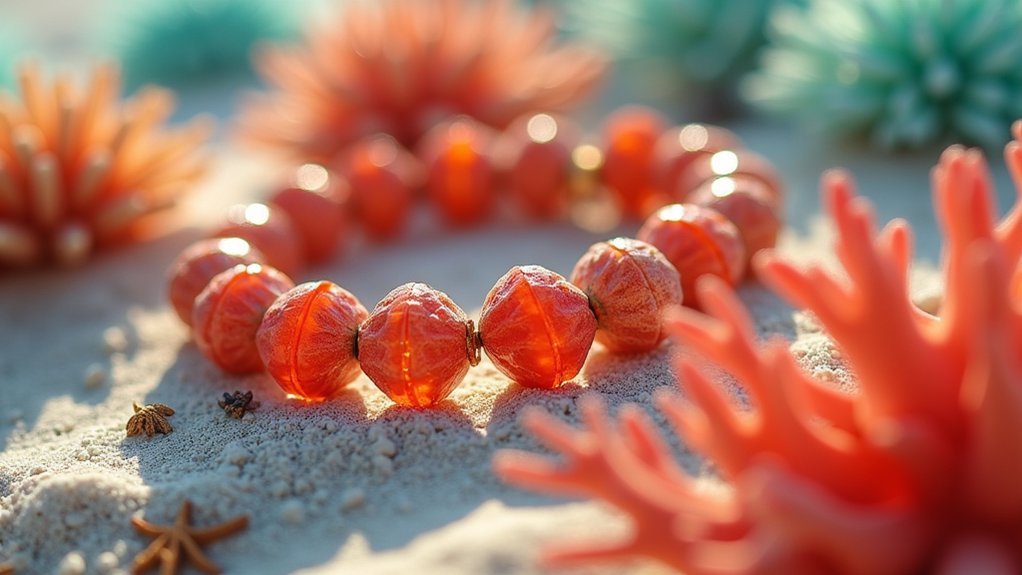
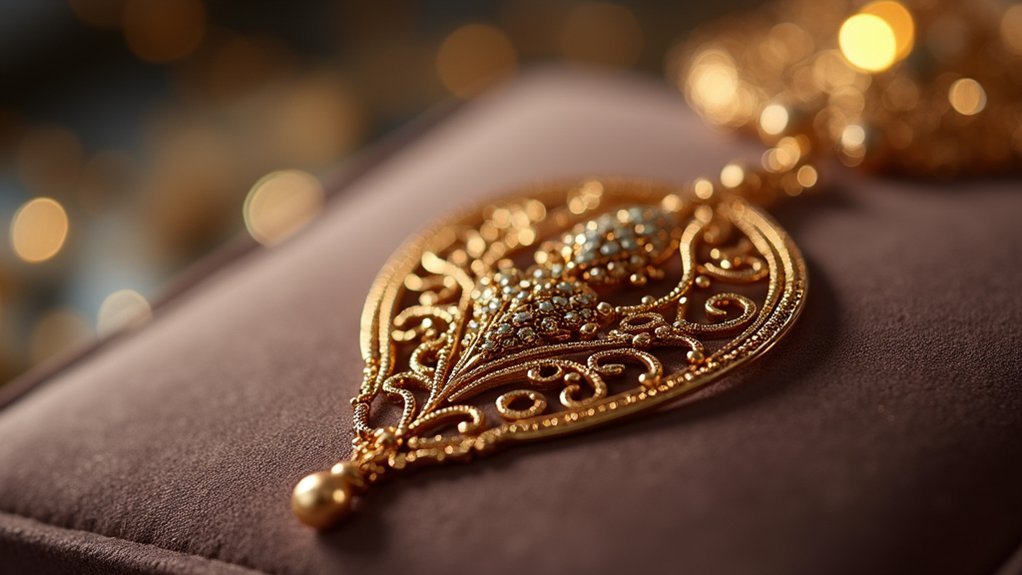


Leave a Reply